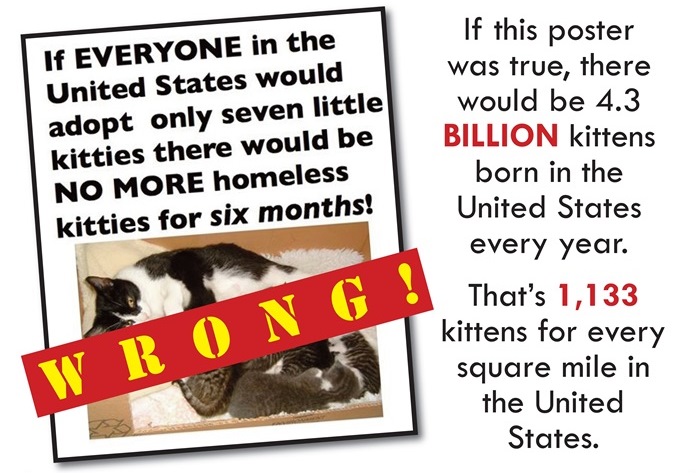
Another completely made up statistic used to legitimize the killing of kittens in shelters. If this were true, that would amount to 4.3 billion kittens a year. That would be over 1,100 kittens every square mile in the U.S., including all the prairies, forests, deserts, and waterways, another obvious absurdity.
There is an epic, willful failure by shelters, city administrators, and large, national groups to understand the true causes of shelter killing and how we can bring that killing to an end. And the lie at the heart of the killing is the false belief that there are too many animals and not enough homes.
Using the most successful adoption communities as a benchmark and adjusting for population, U.S. shelters combined have the potential to adopt almost nine million animals a year. That is almost three times the number being killed for lack of a home. In fact, it is more than total impounds; and of those, almost half do not even need a new home.
Moreover, roughly 23 million people get an animal every year, a number that is growing. And while some are already committed to adopting and others to getting one from a breeder or other commercial source, 17 million have not decided where that animal will come from and research shows they can be influenced to adopt from a shelter. We just have to convince a small percentage of those to adopt from a shelter to zero out the killing. And hundreds of cities and towns across America are proving it, including those with very high per capita intake rates and very high rates of poverty.
Some defenders of shelter killing, however, have argued that these numbers do not tell the whole story because they do not include the animals living on the street, claiming that amounts to as many as 100 million additional animals (1.2 million stray dogs in Houston and 50,000 in Detroit alone). There are many flaws inherent in this argument, the first being that it introduces into the equation a whole category of animals who, while their well-being is important, are not relevant to the very specific discussion of shelter killing for the simple fact that they are not in shelters. One cannot argue, at least in accordance with the rules of logic and evidence, that dogs and cats in shelters must die because there are dogs and cats living on the streets or in the wild. Shelter killing is a distinct harm we have the power to end.
Moreover, the numbers of animals living on the street are, at best, completely made up. In Detroit, for example, no one could cite the source of where the 50,000 number came from. And then the dogs were counted. Preliminary results indicate there are 1,000 to 3,000 dogs, a fifty fold reduction in the actual number. In Houston, the leadership of the city pound stated there were 1.2 million homeless dogs roaming the streets of Houston and it was then cited by a local newspaper. If that were true, there would be 2,000 homeless dogs per square mile in Houston, an absurdity. Now when city leadership is asked for the source of that number, they cite the newspaper article which was quoting them! So what is the actual number of stray animals in the U.S.?
It is tough to say, but let’s look at a worst case scenario. Imagine if the entire country was like Detroit, a city where the infrastructure provided by government has more or less begun to break down. It is poor, bankrupt, suffering from incredibly high unemployment and foreclosure rates, criteria usually associated with lack of spay/neuter and, according to some, high rates of abandonment. Using this extreme example as a norm, there would be just shy of 1,000,000 stray dogs in the entire U.S. (less than what pound leadership claims for Houston alone!) Assuming ten times the number of cats, we’re still looking at a number that is less than total demand. On top of that, many of those cats do not need a home and are not “homeless” as they are not social to humans (the outdoors is their home). And, of course, Detroit is an aberration. It has an unemployment rate twice that of the nation, six out of 10 kids live in poverty compared to two in 10 nationally, and one-third of the city is empty or described as “heavily blighted.”
In the end, animals are dying in shelters not because there are too many of them, but because of how shelters are operated: killing animals out of habit and convenience, even when there are empty cages, often within minutes of arrival, and despite rescue groups ready, willing, and able to save them. To end the killing, we need to stop perpetuating the deadly lie at the heart of the killing and reform our shelters. (Indeed, if Detroit proves anything, it is that Americans love dogs, regardless of their economic status.)
For further reading:
————-
Have a comment? Join the discussion by clicking here.
Here is my story: www.nathanwinograd.com/?p=11902
And this is my vision: http://vimeo.com/48445902